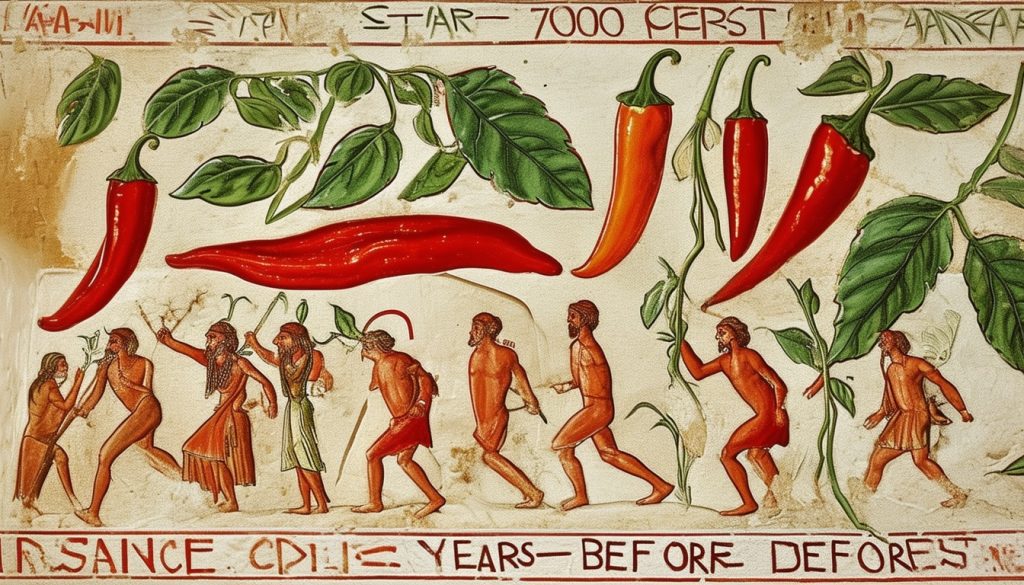Where do the first chili peppers come from?

We talk about hot sauce pretty much non-stop (just ask our other halves), but we can’t really talk about it without talking about peppers. The stars of the sauce show. The main cause of the hotness in hot sauces. A hot sauce simply cannot exist without peppers. But where do they come from? When were the first chili peppers discovered? And what did they do with that “new invention”? We go back in time together for a very hot voyage of discovery.
The place of birth
According to the New Mexico State University Chile Pepper Institute, chili peppers are native to the lowlands of Brazil and were small, round, berry-like fruits[1]. That location in Brazil is also called the ‘nuclear area’. A fitting name, because this area is said to contain the largest number of wild pepper species in the world. They fall under the ‘Capsicum’ genus and come in all kinds of shapes, colors and varying degrees of heat. The pepper plants then depended on their relationship with birds, because they ensured that the fruit spread. Before you worry about the birds and whether or not their sphincter is burning; Birds do not have receptors in their beaks that experience heat the way we do. Another important part: the digestive system of birds leaves the seeds of the peppers intact. So birds eat the pepper, fly with the seeds in their bodies to the next location and poop the seeds out again. This is how the pepper spread to Central America, where it was used by people for the first time.

It was most likely the Aztecs and Mayans who started using the peppers. Nowadays, and especially here in the Low Countries, when we think of spicy food we quickly think of countries such as India, China or Thailand, but chili peppers were only introduced there in the 16th century. About 7,000 years before Christ, chili peppers were already used by the Aztecs and Mayans as sacrifices for the gods, as a status symbol, as medicine, but also as a seasoning. It is not known exactly which peppers they were, but what we do know is that the Mayans were also the first to cultivate pepper plants. These were from the Capsicum Annuum genus, which includes the Jalapeño. There are now 26 different pepper genera known, 5 of which are cultivated by humans:
- Capsicum Annuum (like Jalapeno)
- Capsicum Chinense (like Habanero & Scotch Bonnet)
- Capsicum Frutescens (like Tabasco)
- Capsicum Baccatum (as Aji Amarillo)
- Capsicum Pubescens (like Rocoto)
Capsaicin
The best-known property of peppers is of course the burning sensation they cause. This is thanks to the substance we call “capsaicin”. This is an alkaloid that stimulates the nociceptors on the tongue (and other parts of the body). These receptors are sensitive to heat and pain and that is precisely what the capsaicin causes: a burning sensation and associated pain. The purpose of this vile stuff? Prevent animals other than birds, especially mammals, from eating the fruits. In itself a more than excellent defense mechanism for the plant, if it were not for the fact that there is one mammal on earth that does not care about that pain: humans. In fact, humans enjoy this sensation and even discover other positive properties of capsaicin. This includes medication, anesthesia and even warfare. People are even growing peppers on a large scale and crossing different varieties, so that there are now more than 3,000 (!) different varieties. A hobby that has gotten quite out of hand. Mother Earth probably didn’t think that when the pepper plant evolved.

Would you like to learn more about peppers and the history of hot sauce? We have written a hot sauce book, with a lot of information, history, culture and recipes: HOT SAUCE – The hot sauce bible with 40 spicy recipes. This way you can lecture everyone when it comes to the hottest topic in the world!
[1] https://cpi.nmsu.edu/chile-info/for-kids-pages/the-story-of-chile-peppers.html#:~:text=The%20five%20domesticated%20species%20are, bonnets%20belong%20to%20the%20C.